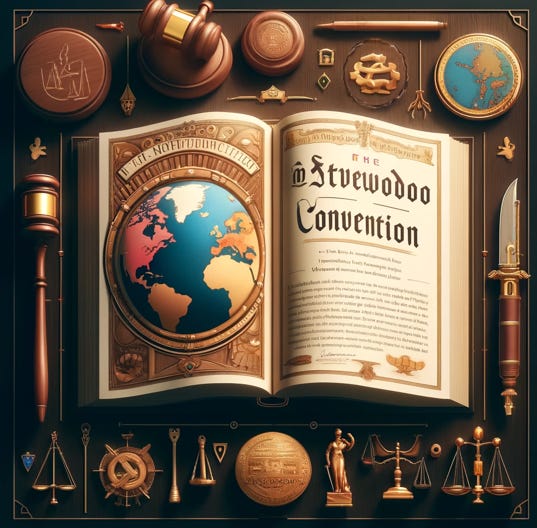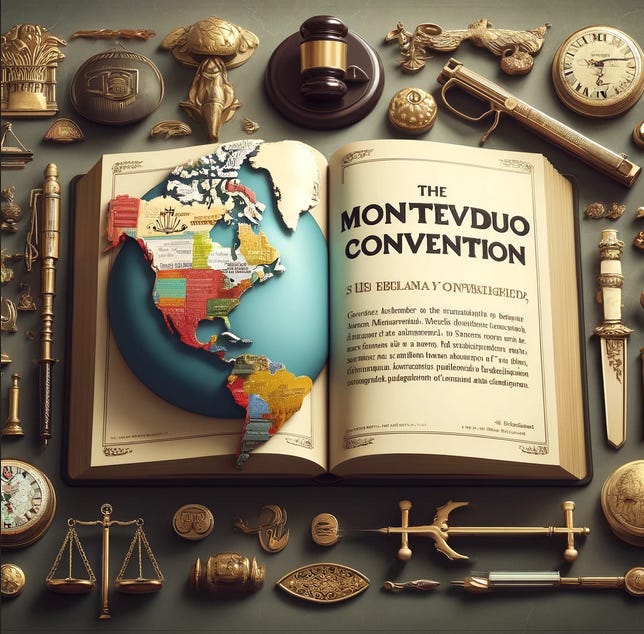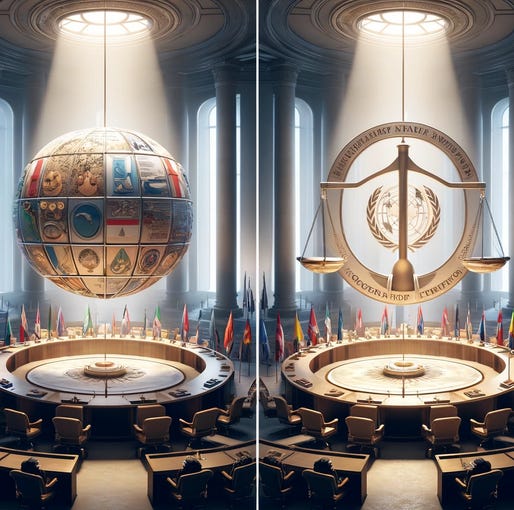Statehood and the Montevideo Convention
It has been widely established that the provisions of Article 1 of the Montevideo Convention, 1933 provided for criteria for Statehood viz: a permanent population, a defined territory, government, and the capacity to enter into relations with other states. The established criteria have sparked both legal and academic debates. The questions could be asked: What exactly is a state? Are the four criteria established in Article 1 of the Montevideo Convention sufficient for Statehood? Since the Convention in 1933, how efficient have the established criteria been? Are these criteria, in fact, sufficient?
The two world wars marked new developments in international law due to the rise in recognised states pre-post-war. Before the First World War, there were about 50 sovereign states; after the Second World War in 1945, there were 75 sovereign states. Both wars heralded a new era of the creation of new states by observing their right to self-determination and secession, which further developed the scope and essence of Statehood since each new entity has to assume Statehood to gain the political, social, and economic relevance among the comity of states at international level.
International law has developed over the years to accord legal recognition to different entities, such as organisations and corporations. However, none of these entities have been under much scrutiny in international law since every other international legal personality derives its validity from an existing and internationally recognised state. In the celebrated Article 1 of the Montevideo Convention, there are four conditions established for state recognition: (i) a permanent population, (ii) a defined territory, (iii) government, and (iv) capacity to enter into relations with the other states.[1]
Before the enactment of the Montevideo Convention, scholars and accomplished authors made several attempts to define what constituted a state. Allgemeine Staatslehre was a seminal paper by George Jellinek that preceded the Montevideo Convention. In his paper, preconditions for Statehood are divided into three, viz; the existence of a defined territory, volk (land), and the existence of Herrscher (a recognised sovereign).[2] In Jellinek’s view, once a state has attained each of the requisites afore-listed, it automatically becomes a legal personality and a natural person.
Rather than an assumed discovery, it is common knowledge that a given entity may not necessarily become a state even after fulfilling the Montevideo Convention requirements. In another instance, an entity can assume Statehood with its rights and recognition without meeting the requirements. These conflicting positions and chaos have given us a haven to conclude that a state is considered a state so far as it exists. However, this poses another recognition problem, which has been considered vital to a given state’s constitutive and functional relevance. It has been suggested that once others duly recognise an entity as a state, such an entity has fulfilled the statehood criteria.[3] The ambiguity of what constitutes recognition is another problem in identifying a state.
Recognition is the focal point of international discourse in attributing Statehood to an entity. However, attaining objectivity in state recognition has been vital in international politics due to states aligning with their political interests, diplomatic benefits, history, economic, and ideological stands. Recognizing an entity as a state or refusing to accord the needed recognition serves as an impediment for entities that would otherwise be qualified; this denies them the capacity to be signatories to treaties and conventions governing international law. For instance, the refusal to recognise the Sahrawi Arab Democratic Republic (SADR) has denied them the right to participate in internationally acknowledged events, which comes with the right to being a recognised state.[4]
In contrast, the United States and many other European nations accorded Bosnia statehood in 1992. Also, they recognised the government of Alija Izetbegovic even though the civil war in Bosnia was still raging at the time, and the government did not effectively have control over its defined territory. During the period of striking a peace accord in 1995, the Dayton Peace Accords between the Alija Izetbegovic government, the Bosnian Serb militias, and the Yugoslav Army, the government was considerably weaker and in a lesser advantaged position than the High Representative, which was appointed by the international community.[5]
Scholars, politicians, and international lawyers have debated what constitutes recognition. The understanding is that recognition is interwoven between politics and law.[6] Recourse could be had to the submission of Kelsen, who argued that recognising the state’s existence is vital in politics. Still, it is only declaratory of an existing statehood that a state had before the recognition.[7]
Again, the lack of attainment of Statehood or the recognition of Somaliland by other states despite fulfilling the four criteria prescribed by the Montevideo Convention has called to question the effectiveness and essence of the four criteria. After self-declaration of independence, Somaliland could not obtain international recognition, which has since served as an impediment to its full status of Statehood. With the politicisation of the state recognition even by the international community, it is yet to be seen how sufficient the four criteria, as expounded in the Montevideo Convention, have been.
In this light, two theories of recognition have been developed, viz., the constitutive theory and the declarative theory of recognition. The Constitutive Theory posits that recognition is merely discretionary, while the Declarative theory posits that the declaration is more of a legal act. These theories have been developed without a clear and concise definition of state recognition in international law as attempts to answer the importance of recognition, which has consistently graced the scene whenever topics about state recognition are discussed, remain unsuccessful. Nonetheless, recognition is significant in state creation and admission into the international community of states.
The discussions surrounding Statehood will continue to be contentious in light of the different results the adherence to the four criteria of Statehood as contained in the Montevideo Convention has generated globally. Many entities that would ordinarily qualify as states after satisfying the four criteria have been denied Statehood, while entities without fulfilling the four criteria have been approved as states. There is also the occasion of microstates submitting their defence to a neighbour with a bigger military capacity, which negates the states’ capacity to enter into legal relations with other states in national security matters. Some states have equally stated their lack of capacity to enter legal relations in the security space independently; they are still recognised states.[1]
Based on the views of contemporary jurists and some state policies, it appears that the traditional criteria for Statehood are being expanded to include additional factors. However, it is worth mentioning that there is little state practice and opinio juris to support the idea that these new criteria have become customary international law. While these policies may provide insight into how international law is evolving, they cannot be the sole basis for determining who does and does not qualify for Statehood without regard for the four criteria specified in Article 1 of the Montevideo Convention.
The discussion surrounding the concept of Statehood holds significant value as it sheds light on the interplay between different viewpoints. The variations in the application of statehood claims are not a result of an abandonment of traditional legal criteria but rather an appropriate implementation of flexibility in interpreting these criteria in light of the presented claim. In the compelling understanding that the classical criteria may not be enough in sole consideration for Statehood, the Montevideo Convention offers an essential criterion that should not be discountenanced.
[1] Milena S., ‘A Grotian Moment: Changes in the Legal Theory of Statehood’, Denver Journal of International Law and Policy, 2011 pp. 209–237 at 226
[1] Montevideo Convention on the Rights and Duties of States, “open-multilateral, Art. 1, (signed 26 December 1933), 165 LNTS, LA 41 TR-08011936 — LoN — 3802,” https://treaties.un.org/pages/showDetails.aspx?objid=0800000280166aef Accessed, 5th January, 2024.
[2] Georg Jellinek, “Allgemeine Staatslehre (2nd edn, O Hä ring 1905)” p. 137.
[3] Hersch Lauterpacht, “Recognition in International Law (CUP 2013)” p. 41.
[4] Martin R. and Bohumil D., ‘Power and recognition: How (super) powers decide the international recognition process,’ 2018, p. 442
[5] Steven L. Burg and Paul S., “The war in Bosnia-Herzegovina Ethnic Conflict and International Intervention,” 1997, p. 127
[6] Herbert W., ‘Recognition of States: Some Reflections on Doctrine and Practice,’ 1949, p. 43
[7] Kelsen H., Recognition in international law: Theoretical observations. The American Journal of International Law 35(4), 1941, pp. 605–617.





